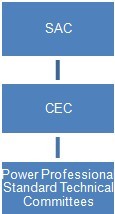from:China Electricity Councildate:2014-01-14
Power Standardization in China
1. Relevant policies
1) Laws and regulations:
Standardization Law of the People's Republic of China
Regulations for the Implementation of the Standardization Law of the People's Republic of China
Administration Regulation of National Standards
Administrative Regulation for Adopting International Standards
Administrative Regulation for Industry Standardization
2) Standards administration authorities in China
a. Standardization Administration of the People's Republic of China (SAC), authorized by the State Council to exercise the administrative functions and carry out centralized administration for standardization in China.
b. Ministry of Housing and Urban-Rural Development of the People's Republic of China, authorized by the State Council to exercise the administrative functions for construction standards and carry out centralized administration for construction standardization in China.
c. National Development and Reform Commission (NDRC), People's Republic of China, the administrative authority for standardization work of 19 industrial fields, including electric power industry.
3) Three levels of standardization administration in power industry

4) Procedures of standards formulating in China

2. Overview of Power Industry Standardization in China
1) History
--In 1950s, the standardization structure in China was established based on that of the former Soviet Union. A lot of standards on power designing, construction, operation, examination and maintenance, and testing were formulated at that time and played an important role in the development of China’s power industry and in ensuring power supply security.
--In 1960s, with the establishment of the Ministry of Water Resources and Electricity, early power industry standards are revised on the basis of practical conditions and experiences while some new standards are formulated.
--In 1980s, administrative departments specialized in power industry standardization were established. Power industry standardization made great progress during this period.
--China Electricity Council started to be responsible for the detailed organization and daily work of standardization of power industry since 1999.
--By now, there are 2162 applicable standards of power industry in China, among which 342 are national standards.
2) Achievements.
--Administration structure of power industry standardization formed and stabilized
--A team of professionals on power industry standardization set up
--Structure and system of power industry standardization established
--Structure of standardization in power enterprises established, and standardization in power enterprises prevailed
3) Power Professional Standard Technical Committees
a. 35 Power Professional Standard Technical Committees, including 42 Standard Technical Committees specialized in electric.
b. 15 national Standard Technical Committees related to power industry
c. Professional team: around 1000 experts directly participate in power industry standardization; every year more than 1800 experts participate in drafting power standards.
3. Globalization
1) Adoption of international standards and advanced foreign standards
This is not only one of the strategic technical and economic policies of China, but an important measure for promoting technology development, improving products quality, expanding opening areas, speeding up access to the international market, and developing market economy. After joining WTO, China attached greater importance to the adoption of international standards and advanced foreign standards, which are closely connected to the steady development of the whole power industry.
2) Active participation in international activities on standardization
Entrusted by China Bureau of Quality and Technical Supervision, activities of 11 IEC Technical Committees in China are managed by the power industry.
Detailed activities include:
--Voting and declaring on international standards representing the People’s Republic of China; sending experts to conferences of the 11 IEC Technical Committees annually.
--Actively hosting related conferences of IEC, expanding communication fields and deepening understanding.
--Cooperating with international equipment producers, e.g. Siemens, carrying out information exchange and cooperation on standards.
3) Goals
--Encourage enterprises to actively participate in international standards formulation.
--With experience in the advantageous fields of China, e.g. live working, relays and protection, we’ll raise more proposals such as live working under ultra high voltage and relays and protection with consideration of system functions etc.
--China will promote cooperation with standardization authorities and power companies of other countries more widely and more actively.
--Establishing mechanism of training and selecting international talents on standardization
Tel:+86-25-84152563
Fax:+86-25-52146294
Email:export@hbtianrui.com
Address:Head Office: No.8 Chuangye Avenue, Economic Development Zone, Tianmen City, Hubei Province, China (Zip Code: 431700) Nanjing Office: Room 201-301, Building K10,15 Wanshou Road,Nanjing Area, China (Jiangsu) Pilot Free Trade Zone,Jiangsu Province,China (Zip Code:211899)
